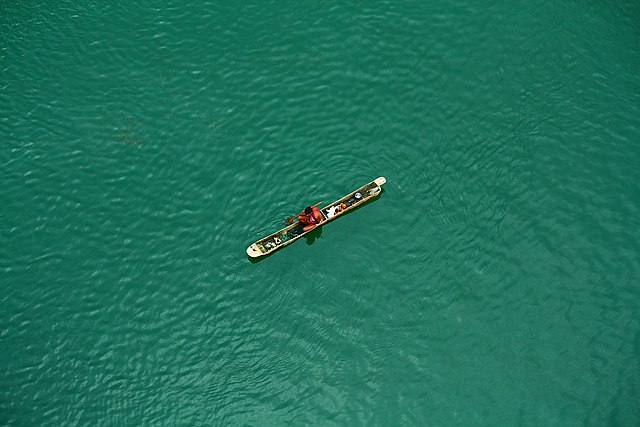 |
| Narmada River |
It originates from Narmada Kund on Amarkantak Plateau near Anuppur district of Madhya Pradesh (MP), forms a traditional boundary between North India and South India, and flow westward over a length of 1312 km covering Indian states of Madhya Pradesh (1077 km), Maharashtra (74 km) and Gujarat (161 km) before emptying into Arabian Sea through Gulf of Khambat.
It is one of the few river which flows through a rift valley. It flows between Satpura and Vindhyas ranges. Other rivers which flows through a rift valley are Damodar river and Tapti.
It is mentioned in Periplus Maris Erythraei as Nammadus. It is known among British as Narbada. It is frequently mentioned in the Mahabharata, the Ramayana and the Puranas. It is one of the seven holy rivers of Hindus. The river is said to be "daughter of Shiva and Ganga". Thus, it is also known by the name "Shankari". Its original name "Narmada" in Sanskrit means "the Giver of Pleasure."
Some of the major cities on Narmada Banks are Dindori (MP), Harda (MP), Mandhata (MP), Barwani (MP), Omkareshwar (MP), Barwaha (MP), Maheshwar (MP), Mandla (MP), Bharuch (Guj), Rajpipla (Guj), Dharampuri (Guj), Vadodara (Guj), and Rajkot (Guj).
Quick Facts about Narmada River
Length: 1312 km
States Covered: Madhya Pradesh, Maharashtra, Gujarat
Source: Narmada Kund, Amarkantak
Mouth: Gulf of Khamabat (Arabian Sea)
Tributaries
There are total 41 tributaries of Narmada river, out of which 22 river are from Satpura range and rest on the right bank from Vindhya Hills. Sher, Shakkar, Dudhi, Tawa and Ganjal joins Narmada on slopes of Satpura Hills from South whereas Hiran, Barna, Choral, Karam and Lohar joins from north side. Tawa is the largest tributary of Naramada. It is estimated 172 km long. Next Sikta and Kaveri are other two important river which join Narmada below the Khandwa plain. The other important tributaries are Karanjan which joins Narmada at Rundha (Narmada District, Gujarat) and Orsang (Aursanga) river which joins Narmada at Vyas Village in Vadodra district of Gujarat.
Narmada, Orsang and Gupta Saraswati forms a Triveni Sangam near Chandod village of Vadodra district, Gujarat. It is known as Dakshini Prayag among local populace.
To sum up, left bank tributaries are Burhner River, Banjar River, Sher River, Shakkar River, Dudhi River, Tawa River, Ganjal River, Chhota Tawa River, Kaveri River, Kundi River, Goi River, and Karjan River, whereas Choral River, Kolar River, Man River, Uri River, Hatni River, and Orsang River.
Basin
The Narmada basin extends over 98796 sq km. It covers Madhya Pradesh (81%), Gujarat (12%), Maharashtra (4%), Chhattisgarh (2%) and Andhra Pradesh (1%).
The basin can be divided in five major regions:
(1) The Upper Hilly Areas: Shahdol, Mandla, Durg, Balaghat and Seoni
(2) The Upper Plains: Jabalpur, Narsinghpur, Sagar, Damoh, Chhindwara, Hosangabad, Betul, Raisen and Sehore
(3) The Middle Plains: Khandwa, part of Khargone, Dewas, Indore and Dhar
(4) The Lower Hilly Areas: part of Nimar, Jhabua, Dhulia, Narmada (district) and parts of Vadodara
(5) The Lower Plains: Narmada (district), Bharuch, and parts of Vadodara.
It mainly consists of black soils. Though, the coastal plains in Gujarat are composed of alluvial clays with a layer of black soils.
Historical Significance
Narmada river valley is of great historical significance. It is one of the earliest places in India where humans (Homo) settled and thrived. The earliest trace of the human activity in Narmada River Valley can be traced back to paleolithic age. The fossilized skull of Narmada man is one such great example. Bhimbetka, where earliest cave paintings are found, also lies in the Narmada River Valley.
Religious Significance
As mentioned earlier, it is one of the seven holy rivers of Hindu. The seven rivers are Ganges, Yamuna, Saraswati, Narmada, Godavari, Sindhu and Kaveri.
Some of the important religious places and Ghats on Narmada river are Narmada kund at Amarkantak hill, Omkareshwar (MP), Maheshwar (MP), Nemawar Siddeshwar (MP), Chausath Yogini (MP), Chaubis Avatar (MP), and Bhrigu Rishi temple (Guj).
Flora and Fauna
Narmada river valley is home to 76 mammals species and 276 bird species. None of them are endemic. Kanha National Park, one of the last home to Indian Bengal Tiger, and inspiration behind The Jungle Book by Rudyard Kipling lies in Narmada River Valley. Hallon and Banjar, tributaries of Narmada, flow through this park. Panchmari Bioreserve, Satpura National Park and Mandla Plant Fossils Park are also part of Narmada River Valley.
Narmada Valley Development Authority
Narmada Valley Development Authority is formed by the Government of Madhya Pradesh to oversee the major dam, canal, and other development projects on Narmada river on 9 August 1985. It is currently working on 29 major, 135 medium, and 3000 minor projects in Narmada river valley.
Dams
Sardar Sarovar Dam, one of the biggest dams of India, is located on Narmada river. Indira Sagar Dam, Omkareshwar Dam, Maheshwar Dam, Bargi Dam, Maan Dam, Jowat Dam, and Tawa Dam are other important dams on Narmada and its tributaries.
Narmada Bachao Andolan
It is not easy to access the environmental impact of a large dam alongside the displacement and migration it causes. A group of tribal, environmentalists and human rights activist formed a group Narmada Bachao Andolan to curb down the overexploitation of Narmada river and force the government agencies for a responsible development.
